Metabolic bone disease in bearded dragon is one of the most health problems in bearded dragons. As bearded dragon owner, you need to know about this disease.
After reading this guide, you will be able to recognize Metabolic Bone Disease (MBD) causes, signs, symptoms, treatment, and how to prevent it.
What Is Metabolic Bone Disease in Bearded Dragons?
Also known as fibrous osteodystrophy or secondary hyperparathyroidism, metabolic bone disease describes a wide array of nutritional deficiencies, mostly calcium, Vitamin D3, and phosphorus.
Regardless of the cause of MBD, it’s mainly caused by calcium. When the calcium levels go below what is needed, the dragon’s body starts utilizing the calcium from bones and other places to try and cover the deficit.
The result is that bones are damaged as they become soft and easily breakable while the muscles lose their ability to contract.
It’s perhaps why MBD results in partial or total limb paralysis. Tissues are also damaged as they pull the weak bones in an attempt to fortify them.
With MBD, dragons become weak as their bones deteriorate, leaving them feeble and headed for death if left untreated.
Metabolic bone disease can even leave the beardie deformed, with limbs that drag as they move.
To minimize the chance of metabolic bone disease in beardies, provide a calcium supplement to ensure the reptile gets enough nutrients.
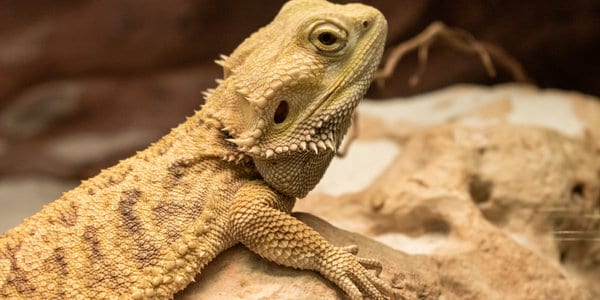
How Do Bearded Dragons Get Metabolic Bone Disease?
There are many causes of MBD in bearded dragons, but all of them are deficiencies. So it’s safe to assume that it’s caused by inadequate care. The most common causes of MBD include:
1. Too much or inadequate calcium
Bearded dragons need lots of calcium to keep their bones strong. Beardies get the right amount of this mineral from various plant and animal sources in the wild.
However, there’s a need to supplement their diet with calcium in captivity.
A calcium-rich diet allows them to produce more Vitamin D3, which is responsible for bone health and much more.
To ensure the continuous supply of calcium in your bearded dragon’s diet, you should dust their feeder insect with it.
There have been rare cases where reptile owners provide the wrong calcium supplement, preventing beardies from absorbing enough calcium.
As such, look for the most easily digestible calcium supplements.
However, many pet owners make the mistake of giving their bearded dragons’ excess calcium to keep them healthy. This, as a result, could be counterproductive and damage the bones, leading to MBD.
2. Insufficient UVB exposure
Without UVB, it’s practically impossible for the bearded dragon body to convert Vitamin D to vitamin D3 properly through the skin.
UVB is also useful for healthy metabolism in beardies and allocating the D3 to the skeleton. You could be feeding your beardie with all calcium supplements, but you must use the right UVB lighting to harness it.
The issue with most beardies in captivity is they find it impossible to get enough UVB because the waves do not pass through the glass.
That’s why you may need to purchase a high-quality UVB bulb and replace it after every six months. Also, ensure to put them on for about 12 hours per day.
3. Too much phosphorus in the diet
If the phosphorus to calcium ratio is off, where there’s more phosphorus than calcium, then MBD is a potential risk.
Vegetables are the main source of phosphorus for bearded dragons, but you can also find them in bananas and some beans.
To maintain balance, look for calcium powder that doesn’t have phosphorus, as they are likely to get enough from the greens.
4. Too many oxalates in the diet
Oxalates are naturally occurring in most foods that contain two carboxylic acids. You should not feed beardies such foods as the oxalates disrupt the body’s ability to absorb calcium fully.
You should avoid kales, carrots, collards, and spinach as these contain lots of oxalates. However, there’s nothing wrong with feeding your beardie these greens occasionally.
5. Low temperature
Beardies are ectotherms and rely on heat to fully digest their food and absorb key minerals like calcium.
If the tank lacks proper heating, it becomes too cold, so your beardie won’t absorb enough calcium, increasing the MBD risk.
One of the ways to prevent and treat MBD is to provide a basking spot and keep the temperature between 95 to 100 degrees Fahrenheit.
6. Not enough room
Sometimes the issue is not with the nutrition, lighting, and supplementation.
The vivarium must offer enough room for your bearded dragon to move around. Without some exercise, beardies are prone to MBD.
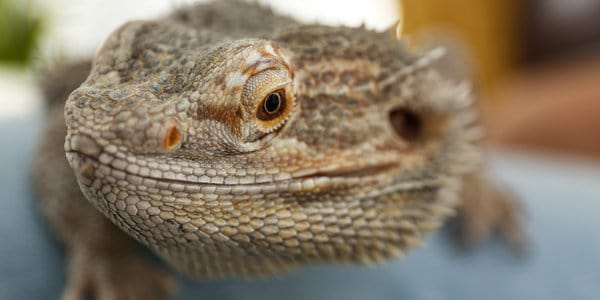
5 Early Signs of Metabolic Bone Disease in Bearded Dragons
As the lack of calcium makes a beardie’s bones become soft, the muscles lose their ability to contract though this happens towards the late stages of MBD.
However, the disease does present some early symptoms, which unfortunately are found in a broad range of conditions. These early symptoms include:
1. Lack of appetite
Healthy bearded dragons are often enthusiastic omnivores with a strong desire to eat.
This appetite wanes off during the early onset of MBD, and the stress associated with it can make it harder for a beardie to digest food leading to a lack of appetite.
2. Stress
When a beardie begins to undergo a calcium shortage, its stress levels go up, an instinct that helps them survive in the wild.
The beardie will increasingly become agitated and appear quite stressed as MBD progresses.
3. General weakness
A bearded dragon with metabolic bone disease will become weak over time.
This is mainly due to the lack of appetite, and as their body continues to run out of nutrients to maintain proper functionality.
They will tend to lay down on their bellies as lifting their bodies is often too taxing on the weak bones.
4. Constipation
MBD triggers gastrointestinal complications in bearded dragons, which often leads to constipation.
This symptom is present in other complications and should be dealt with the seriousness it deserves as the lack of treatment can lead to further abdominal discomfort.
5. Lethargy
As MBD progresses, the bearded dragon is forced to use up its fat storage to maintain normal bodily functions leaving the reptile depleted.
This lack of energy and enthusiasm is often accompanied by reduced responsiveness and inactivity.
When you call them, you can notice lethargy in your beardie, and they don’t even have the energy to lift their heads.
5 Late Stage MBD Symptoms in Bearded Dragons
The calcium loss associated with MBD results in adverse effects and tissue loss when left untreated.
This occurs when the body tissue surrounding the weak bones gets pulled tight in an attempt to fortify the bones resulting in tissue and muscle damage.
Here are some late-stage MBD symptoms:
1. Tremors
MBD causes the muscles surrounding the weak bones to twitch and tremor, a noticeable condition in the toes and feet.
When they walk, the leg muscles become quite shaky, and they have difficulty controlling the tail.
2. Softened jawbones
MBD causes the jawbones and the facial skeleton of the beardie to change due to degenerative changes in these bones.
The rubber jaw condition occurs when the body attempts to strengthen the weak bones with softer connective tissues.
3. Stunted growth
MBD stunts a beardie’s growth just like any other infection. The stunted growth is also accompanied by gradual weight loss as the beardie uses up its fat storage and loses muscle tissue.
4. Limb paralysis
The gradual loss of bones leads to limb paralysis when MBD is left untreated in bearded dragons.
This is seen in uncoordinated and eventually complete loss of usage of limbs, tails, and toes.
The loss of limb paralysis is associated with the loss of motor functions and is often accompanied by seizures.
5. Bone fractures
Severely curled bones eventually fracture, and the areas where the beardie’s bones have broken are quite noticeable.
These fractures occur when the bearded dragon attempts to move the weakened limb, and its weight causes the bones to snap.
If you notice any abnormal protrusions along the beardie’s limb cage that might indicate bone fractures, you should immediately contact the vet.
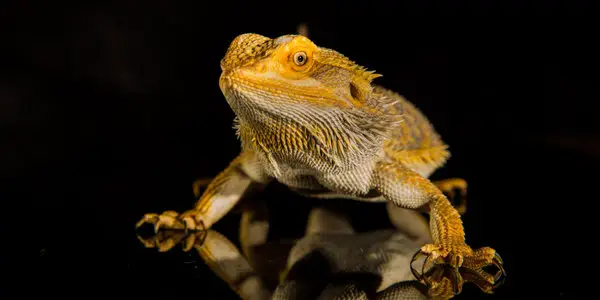
How to Prevent Metabolic Bone Disease in Bearded Dragons?
1. Provide a healthy diet
Providing a healthy diet for your bearded dragon is best to prevent metabolic bone diseases. The meals should be rich in calcium and low in oxalates and phosphorus.
You should also consider switching to certified organic produce to avoid any harmful chemicals that might further impact the health of your pet beardie.
You should consider supplementing your beardie’s meals with the following sources of calcium: cactus leaves, endive, escarole, mustard greens, papaya, squash, and cherry.
Other rich sources of calcium include hornworms, silkworms, and phoenix worms.
2. Provide enough freshwater
Your bearded dragon requires a constant fresh water supply to optimally absorb calcium and synthesize vitamin D3.
Make sure that the bowl isn’t too deep for your beardie, and remember to change the water daily.
3. Provide proper UVB lighting
Bearded Dragons require proper lighting with enough UVB rays to synthesize vitamin D3, which is crucial for calcium absorption.
The enclosure should have appropriate lighting and heating as beardies need an external heat source to support their digestive process.
The UVB light must be on for a minimum of 12 hours every day, and remember to replace the bulbs every six months.
4. Get dietary supplements
As your juvenile bearded dragon is growing, their calcium needs will increase, and it’s recommended to add calcium supplements to their food.
This ensures that they get enough calcium, and the supplements are often fortified with vitamin D3.
You can also get a cricket shaker to sprinkle calcium powder over the beardie’s food.
5. Provide adequate room
Your bearded dragon’s vivarium should have enough room for your pet to move around comfortably.
Researchers have observed that beardies that get more exercise have healthier bones than those stuck in small enclosures.
Even with proper lighting and supplementation, your bearded dragon still needs to exercise daily to build up healthy bones and prevent MBD.
6. Handle your bearded dragon often
Besides getting to know your pet beardie more, there are health benefits that come with handling them often, such as noticing any odd bumps, lumps, and swelling.
This regular inspection will help you see any early symptoms of MBD, and with proper vet care, your pet beardie will prevent long-term bone damage.
7. Avoid oxalate foods
Foods with oxalate compounds prevent the absorption of calcium which can cause MBD. Foods like kale, carrots, collards, chards, and spinach contain oxalate, which binds with calcium.
Foods with high phosphorus levels also prevent the absorption of calcium. These include bananas and nuts, which you shouldn’t feed your beardie.
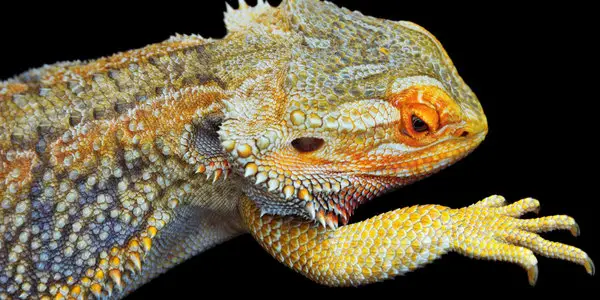
How Do You Treat Metabolic Bone Disease in Reptiles?
Whether you suspect that your beardie has contacted MBD or you just came home from the vet with that sobering diagnosis, there are a few things you can do to care for your dragon and help him recover as quickly as possible.
1. Contact your vet
As soon as you notice the symptoms, however mild, you should reach out to your vet.
You could still use any helpful resources online (like this one), but we must emphasize the importance of consulting a vet.
The vet should not take a lot of time with the examination, which shouldn’t be overly costly. Blood work and X-rays may be advised on how affected your beardie is.
X-rays are useful in detecting fractures and form a great first step in determining how the recovery fairs over time.
The vet will help you determine the perfect treatment to consider from the results.
2. Oral calcium
One of the obvious first steps to consider, especially when MBD is caught early, is the oral calcium administration and Vitamin D.
If oral administrations are found to be ineffective due to slow absorption rate, injections of calcitonin or calcium gluconate are likely to be used.
The goal of this treatment is to add calcium to the beardie bones. You should combine this with proper UVB lighting to work.
A UV meter is also recommended to ensure that the rays are reaching the beardie and any UVB lighting deficiencies need to be corrected immediately.
In addition, your vet will make recommendations for the beardie’s diet, particularly whole foods, as these are more easily absorbed than added powder. Whole foods high in calcium include:
- Dandelions
- Squash
- mustard green
- papaya
- escarole
- Chicory
- Cactus leaves
- Prickly pear
- Figs (in moderation)
- Endive
You can also supplement their diet with calcium-rich insects like
- Hornworms
- Silkworms
- Phoenix worms
Also, you should not feed the beardie food high in phosphorus or oxalates.
3. Handle the bearded dragon with care
You already know that bearded dragons suffering from metabolic bone disease undergo discomfort and pain.
As such, make sure you only handle the dragon when necessary. If you have to pick up the beardie, do it with extreme care, especially if the condition is in advanced stages.
4. Remove hazards from the cage.
When your bearded dragon is diagnosed with MBD, his bones are soft and can easily be broken.
Additionally, it becomes very painful and difficult to move around, even during the early stages of the illness.
You should make your bearded dragon’s terrarium as hazard-free as possible. This may require you to do some rearranging such as:
- Removing any rocks and sticks that make cause your dragon to fold or become stuck
- Provide a shallow water dish to minimize climbing and the risk of drowning as the bearded dragon can’t move fast
- Ensure anything left in that cage is easy to climb, e.g., the basking spot/rock
5. Make sure there’s proper UVB lighting
Being cold-blooded creatures, bearded dragons cannot generate their body heat. They need external heat and light sources to survive.
Without the specific heating and exposure to UVB, beardies can’t digest their food or absorb nutrients. That’s why UVB lighting plays a central role in preventing and recovering MBD.
Your vet will likely recommend a self-ballasted mercury vapor UVB lamp because it can emit both UVB heat and rays. Make sure you do the following:
- Make sure the bearded dragon gets exposed to UVB rays for at least 12 hours every day
- The basking spot inside the terrarium should be about 90 to 100 degrees Fahrenheit hot. Make sure there’s a cool side in the tank set up to help the dragon regulate the temperature as needed
- Make nighttime cooler than the daytime, preferably 65-75 degrees Fahrenheit
- Keep a thermometer to monitor the temperature inside the terrarium and replace the bulb every six months for efficiency
6. Offer enough hydration
Water is an integral part of their health as it helps the dragon absorb nutrients like calcium, vitamin D3, and more.
Ensure the bowl isn’t too deep to make it easier for the beardie, and you also need to ask the vet how much water is enough for them.
If the condition is not advanced, bathing the beardie may boost hydration.
Remember that MBD takes time to develop, so it’s likely taking time to be cured. Follow your vet’s instructions keenly and trust that your beardie will be back to its best.
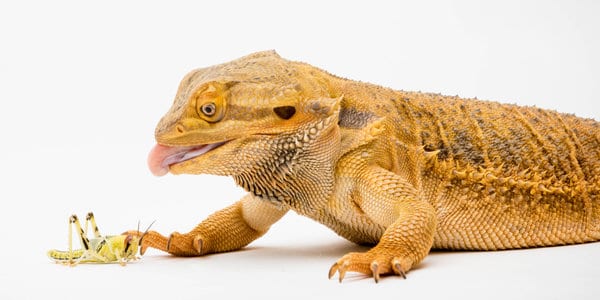
How Long Does It Take for the Bearded Dragon to Recover From MBD?
The recovery time for this condition will vary from one bearded dragon to the other, depending on the severity of the illness.
The fact is that severe metabolic bone disease will require lots of effort and may take longer to cure than mild MBD.
The type of care you offer the lizard will also impact how long recovery takes. Some beardies take weeks, while others may take months, depending on many factors.
If you wish to boost recovery, you should keenly follow your vet’s instructions.
But generally, this is what you need to do:
- Provide a healthy diet rich in calcium
- Offer oral calcium supplements
- Provide special UVB lighting
- Give calcitonin injections
- Offer vitamin D3 injections
Can Metabolic Bone Disease Kill Bearded Dragons?
Yes, if left untreated, MBD can be fatal and lead to the untimely death of your beardie.
To save your bearded dragon, make sure you visit the vet in good time. Since the condition is not common, the symptoms are easy to see early.
If you suspect that your lizard has the disease, you should rush to the vet in the early stages for treatment.
Unlike viral and bacterial infections that are hard to treat, beardies respond to most MBD treatments and won’t die as long as you follow the vet’s advice and treatment plan.
Can Baby Bearded Dragons Get Metabolic Bone Disease?
Yes, baby bearded dragon can get metabolic bone disease.
Metabolic bone disease is more common in young bearded dragons below two years old. The exact age the disease may develop may vary from lizard to lizard, depending on a wide range of factors.
Besides, MBD can progress fast or slow in juveniles. Nonetheless, it’s easy to prevent the disease by offering a calcium-rich diet and proper UVB lighting.
Also, you need to provide proper care from day one when they hatch to stay away from metabolic bone disease.
Wrap Up
Bearded dragons can enjoy a happy and healthy life if you feed them a healthy diet rich in calcium.
When this fails to happen, bearded dragons, especially juveniles, contract metabolic bone disease.
While the condition is treatable, it may leave your pet beardie with long-term health complications if detected on time, so get in touch with the vet as soon as you notice any symptoms associated with MBD.
